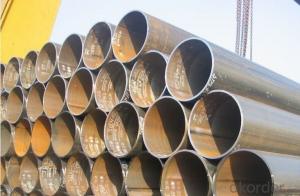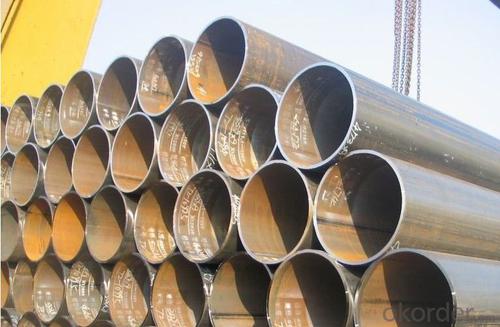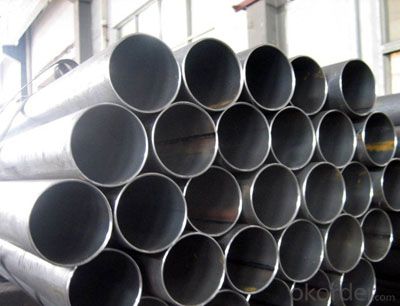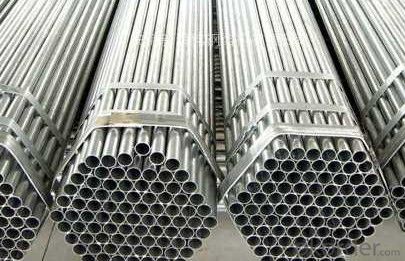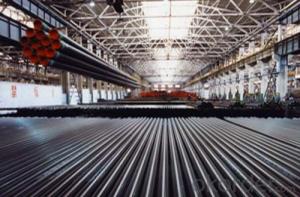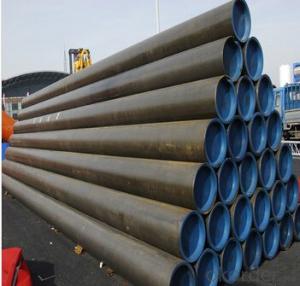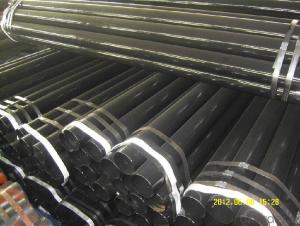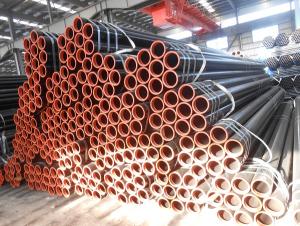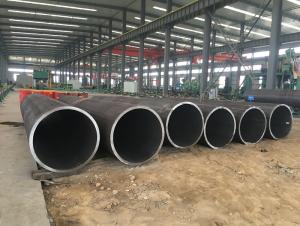SSAM Steel Pipe for Gas Oil Water Conveying
- Loading Port:
- Tianjin
- Payment Terms:
- TT OR LC
- Min Order Qty:
- 25 m.t.
- Supply Capability:
- 7500 m.t./month
OKorder Service Pledge
OKorder Financial Service
You Might Also Like
1、Welded SSAM Steel Pipe GB9711.2:
GB9711.2 SSAM Steel Pipe is electric resistance welding, the abbreviation for Oil for transporting oil and natural gas vapor liquid objects, can meet the requirements of high and low pressure, the transport in the world with pipe sector accounted for a pivotal position.
2、Main Features of Welded Black SSAM Steel Pipe GB9711.2:
• High manufacturing accuracy
• High strength
• Good visual effect
• Reasonable price
• Small inertia resistance
• Strong heat dissipation ability
3、Welded Black SSAM Steel Pipe Specification GB9711.2:
Standard | GB, DIN, ASTM ASTM A106-2006, ASTM A53-2007 |
Grade | 10#-45#, 16Mn 10#, 20#, 45#, 16Mn |
Thickness | 1 - 33 mm |
Section Shape | Round |
Outer Diameter | 21 - 610mm |
Place of Origin | Tianjin, China (Mainland) |
Secondary Or Not | Non-secondary |
Application | Hydraulic Pipe |
Technique | Cold Drawn |
Certification | API |
Surface Treatment | factory state or painted black |
Special Pipe | API Pipe |
Alloy Or Not | Non-alloy |
Length | 5-12M |
Outer Diameter | 21.3-610mm |
Grade | 20#, 45#, Q345, API J55, API K55, API L80, API N80, API P110, A53B |
Standard | ASME, ASTM |
1) Material:20#(ASTM A 106/A53 GRB.API5LGRB,GB),45#,16Mn,10#.
2) Specification range:OD:21.3-610mm,WT:6-70mm,length:6-12m or according to the requirement of clients.
3) Excutive standards:GB,ASME API5L.ASTM A 106/A53,Despite of the above standards,we can also supply seamless steel pipe with standard of DIN,JIS,and so on,and also develop new products according to the requirements of our clients!
4) Surface:black lacquered,varnish coating or galvanized.
5) Ends:Beveled or square cut,plastic capped,painted.
6) Packing:bundles wrapped with strong steel strip,seaworthy packing.
4、Packaging & Delivery
Packaging Details: | seaworthy package,bundles wrapped with strong steel strip |
Delivery Detail: | 15-30days after received 30%TT |
5、FAQ of Welded Black SSAM Steel Pipe GB9711.2:
①How is the quality of your products?
Our products are manufactured strictly according to national and internaional standard, and we take a test
on every pipe before delivered out. If you want see our quality certifications and all kinds of testing report, please just ask us for it.
Guaranteed: If products’ quality don’t accord to discription as we give or the promise before you place order, we promise 100% refund.
②How about price?
Yes, we are factory and be able to give you lowest price below market one, and we have a policy that “ for saving time and absolutely honest business attitude, we quote as lowest as possible for any customer, and discount can be given according to quantity”,if you like bargain and factory price is not low enough as you think, just don’t waste your time.Please trust the quotation we would give you, it is professional one.
③Why should you chose us?
Chose happens because of quality, then price, We can give you both.Additionally, we can also offer professional products inquiry, products knowledge train(for agents), smooth goods delivery, exellent customer solution proposals.Our service formula: good quality+good price+good service=customer’s trust
SGS test is available, customer inspection before shipping is welcome, third party inspection is no problem.
6、 Welded Black SSAM Steel Pipe Images GB9711.2:
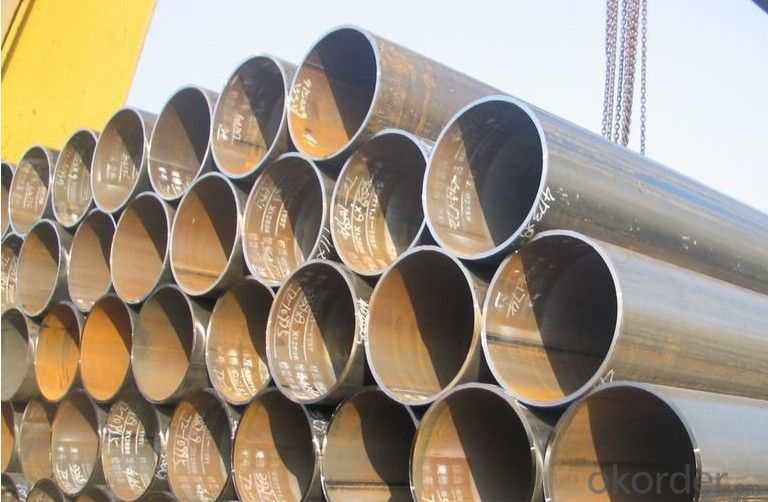

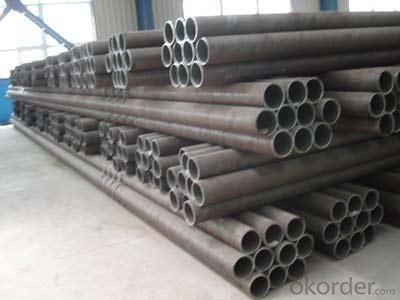
- Q: What is the standard length of steel pipes?
- The standard length of steel pipes varies depending on the industry and application. However, common standard lengths for steel pipes range from 18 to 22 feet, with some variations based on specific requirements or international standards.
- Q: Can steel pipes be used for conveying compressed air?
- Yes, steel pipes can be used for conveying compressed air. Steel pipes are known for their high strength and durability, making them suitable for handling high-pressure applications such as compressed air systems. Additionally, steel pipes are resistant to corrosion and can withstand extreme temperatures, making them a reliable choice for conveying compressed air.
- Q: What are the different types of steel pipe joints for underwater applications?
- There are various types of steel pipe joints commonly used for underwater applications, including buttweld joints, socket weld joints, and threaded joints. These joints provide secure connections and maintain the integrity of the pipeline system in underwater environments.
- Q: Are steel pipes suitable for use in chemical plants?
- Yes, steel pipes are generally suitable for use in chemical plants. They are known for their high strength, durability, and resistance to corrosion, making them well-suited for transporting various chemicals and fluids. Additionally, steel pipes can withstand high temperatures and pressures, making them a reliable choice for the demanding conditions often found in chemical plants.
- Q: Can steel pipes be used for electrical conduits?
- No, steel pipes are not typically used for electrical conduits as they are conductive and can pose a safety risk. Electrical conduits are usually made of non-conductive materials such as PVC or metal with insulating coatings.
- Q: Can steel pipes be used for fencing or railing?
- Yes, steel pipes can definitely be used for fencing or railing purposes. Steel pipes are known for their durability, strength, and resistance to corrosion, making them a popular choice for construction projects like fencing and railings. They provide a sturdy and long-lasting solution for securing properties or creating barriers, while also offering an aesthetically pleasing and modern look.
- Q: Difference and application of seamless hot rolled pipe and cold drawn pipe in seamless steel tube
- type3.1, seamless steel pipe according to the different production methods can be divided into hot-rolled pipe, cold rolled tube, cold drawn tube, extrusion tube and so on3.2, according to the shape of the classification of circular tubes, special-shaped tubes of the division, except the square tube and rectangular tube, there are elliptical tube, semicircle tube, triangle tube, hexagonal tube, convex shaped tube, plum shaped tube and so on3.3, according to the different material, divided into ordinary carbon structure tube, low alloy structure tube, high quality carbon structure tube, alloy structure tube, stainless steel tube and so on3.4, according to special use, there are boiler tubes, geological pipes, oil pipes and so on
- Q: Can steel pipes be painted?
- Yes, steel pipes can be painted. Painting steel pipes not only enhances their appearance but also provides protection against corrosion and rust. The process typically involves cleaning the pipes thoroughly, applying a primer, and then coating them with a suitable paint.
- Q: How to make the internal tooth of the steel pipe?
- Compared with the ordinary light pipe, tube can effectively prevent the formation of steam film between the seal and the pipe wall, increase the light disturbance flow inside the tube, the tube wall temperature is more uniform, which can avoid the light pipe damage, and improve the heat transfer efficiency of boiler. The number of thread head of internal thread pipe is 4, 6 head and 8 head according to need. The main materials are 20G, SA210C, T2, T12, 12Cr1MoVG, 15CrMoG, T22, T23 and so on. China needs 2.5~3.0 tons per year of inner thread tube.
- Q: Can steel pipes be used for LNG terminals?
- Yes, steel pipes can be used for LNG terminals. Steel pipes are commonly used in LNG terminals for transporting and distributing liquefied natural gas due to their strength, durability, and ability to withstand extreme temperatures and pressures. Additionally, steel pipes can be easily welded and have excellent corrosion resistance, making them suitable for the transportation and storage of LNG.
Send your message to us
SSAM Steel Pipe for Gas Oil Water Conveying
- Loading Port:
- Tianjin
- Payment Terms:
- TT OR LC
- Min Order Qty:
- 25 m.t.
- Supply Capability:
- 7500 m.t./month
OKorder Service Pledge
OKorder Financial Service
Similar products
Hot products
Hot Searches
Related keywords
